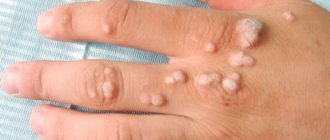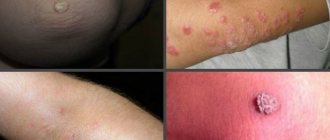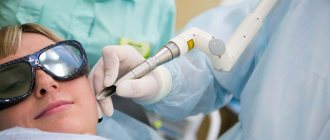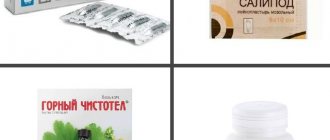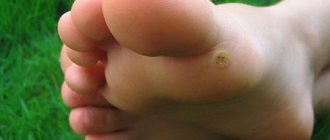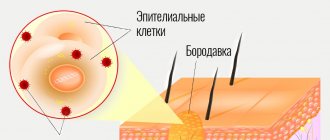Warts on the hands are a benign viral disease in which single or multiple rounded protruding papules of various sizes appear on the skin - from 1 mm to 1.5 cm (sometimes more), gray or flesh-colored. In addition to the skin of the hands, warts can appear on other parts of the body (face, anogenital area, soles of the feet, etc.), as well as on mucous membranes.
The formations tend to spread, merge into large conglomerates, rapidly grow, bleed when injured, and relapse. Self-treatment using questionable methods leads to the appearance of scars, and malignant degeneration is possible on the mucous membranes. Therefore, the problem cannot be ignored.
Sometimes warts can disappear without treatment within 2 years. However, you should not rely on this, since the pathogen still remains in the body and, against the background of a weakened immune system, the formations will make themselves felt again. And over time, they may become less sensitive to therapeutic effects. Therefore, it is important to remove them and, in some cases, undergo antiviral therapy and immunocorrection.
Complications of small warts
Even the smallest warts on the chin or other parts of the body can cause complications.
Including life-threatening ones.
Some types of papillomavirus can cause cancer.
These are squamous cell skin cancer, cervical carcinoma, cancer of the penis, esophagus, larynx, and rectum.
The appearance of a tumor is usually preceded by precancerous processes.
They can be identified during the examination.
These processes have been going on for years.
Therefore, if a person monitors his health and visits a doctor, then he is protected from these complications.
Because if foci of pathologically altered epithelium are detected, they can be removed.
As a result, transformation into cancer does not occur.
If a person ignores his illness, is not examined and is not treated, then he puts himself at risk.
People who are not bothered by small warts or if they are in places inaccessible for self-examination do not go to the doctor.
Other possible complications:
- wart rupture and bleeding;
- inflammatory processes due to bacterial superinfection;
- scar formation as a result of mechanical damage to warts.
Sometimes borderline tumors develop.
With anogenital localization, human papillomavirus infection can occur in the form of giant Buschke-Levenshtein condyloma.
It is characterized by infiltrative, destructive growth.
The tumor grows, destroying surrounding tissue.
It reaches enormous sizes and often recurs after removal.
Therefore, the overall mortality rate for giant condyloma reaches 60%, despite the possibility of surgical treatment.
Causes of warts
Of course, toads and other amphibians have nothing to do with the appearance of warts. But viruses do—namely, the human papillomavirus (HPV). It is the causative agent that forms these tumors. You can become infected with the virus in a variety of ways: from sexual contact to a simple handshake. In addition, HPV is very resistant to antiseptics and tenacious, and therefore can be picked up through the use of common household items (towels, slippers, etc.) and in public places.
HPV is transmitted through mucous membranes and (less likely) through microcracks in the skin. This means that people with chronic dermatological diseases that are accompanied by itching (for example, psoriasis) are more likely to become infected with papillomavirus - the skin does not provide adequate protection, and it is easier for the virus to enter the body.
Let's look at the most popular papillomavirus infection scenarios:
- Sexual intercourse. This is how anogenital neoplasms mainly spread - this is a type of wart that is localized on the mucous membrane around the genitals. By the way, a condom is not 100% reliable protection against such infection: the virus can enter the body through microcracks around the genitals. Treatment of warts of this type is the most difficult and unpleasant.
- General life. HPV is resistant to many antiseptics, so common things can contribute to the transmission of the virus. You can become infected with the virus from household members, using, for example, a shared towel.
- Public places. In public toilets, swimming pools, locker rooms and other similar places, the papillomavirus can exist for some time, waiting for a “victim”. Therefore, in public places you should, if possible, not touch anything with bare parts of your body (for example, you should wear slippers in the pool - this is where plantar warts are most often infected).
- During childbirth. If the mother is infected with HPV, then during childbirth the child has a high chance of becoming infected with the virus.
- Touching. This happens quite rarely, but a person can still become infected with HPV through simple touches - for example, shaking hands. The virus is transmitted through microcracks in the skin. Accordingly, if the integrity of the skin is compromised, the risk of infection becomes higher.
Please note that HPV infection does not always mean that a person will develop warts. In approximately 90% of cases, the carrier has no clinical manifestations. In the remaining 10% of cases, HPV causes warts of various types to appear on the skin.
How to get rid of small warts
It is better to get rid of warts earlier.
Don't wait until they reach large sizes.
Moreover, there is no need to wait until the wart becomes the cause of a malignant tumor.
It is better to go to the doctor and remove all formations once and for all.
This will require a total of 1-2 hours of your time.
Removal will be safe and completely painless.
But all warts are guaranteed to disappear.
And with proper medical treatment, the risk of their reappearance will be minimized.
There are several types of treatment that a person with small warts on the body can receive.
He is receiving systemic therapy.
It is aimed at destroying viruses in the body.
A person is prescribed immunomodulators and antiviral drugs.
Treatment is also used to remove the warts themselves.
What to do if a wart hurts
If the wart has been damaged, the area of skin should be treated with hydrogen peroxide and bandaged or covered with a plaster. The next step should be to contact a dermatologist to assess the extent of the damage and determine further actions. The doctor may prescribe some treatment or recommend removal of the wart.
If the wart begins to hurt for no apparent reason, while other symptoms of a malignant formation are present, you should consult a dermatologist or oncologist as soon as possible. The doctor will conduct the necessary studies and, depending on their results, determine further treatment.
Delay in this case is unacceptable, because Melanoma (skin cancer) develops at a very fast pace and, if you contact a doctor late, is practically untreatable. Therefore, if alarming symptoms are detected, you should seek medical help as soon as possible.
Preparations for the treatment of small warts
You can remove warts using the following methods:
- cytotoxic;
- chemical;
- physical.
The first two involve treating the skin with special preparations.
With the cytotoxic method, the skin is treated repeatedly.
With chemical treatment, a single treatment is carried out, as a result of which the wart tissue dies and is rejected.
Podophyllotoxin is mainly used for cytotoxic removal.
This is an extract of the roots of Podophyllum thyroid.
Apply it for 3 days in a row.
Then they take a break for 4 days.
If the warts do not disappear, the course is repeated.
There can be no more than five such courses in total.
If there is no effect, other, more effective treatment methods are used.
Possible side effects of using podophyllotoxin:
- redness;
- burning;
- pain;
- ulcers at the site of application;
- edema.
When removing warts on the penis, balanoposthitis may develop.
If an excessively large dose is used or a large area is treated, the components of the drug may be absorbed into the blood.
Then systemic side effects occur:
- nausea;
- dizziness;
- diarrhea;
- increase in body temperature;
- a decrease in the number of blood cells due to suppression of red bone marrow function;
- the appearance of ulcers in the mouth.
Chemical removal methods are also used.
For this purpose, concentrated solutions of alkalis or acids are used.
That is, substances that cause chemical burns of the skin followed by necrosis and tissue rejection.
Such drugs are often used by patients on their own.
Although this possibility is not specified in the instructions.
It states that removal can only be performed by a doctor experienced in performing this type of procedure.
Chemical removal is dangerous if done incorrectly.
It is necessary to treat the skin located nearby with Vaseline or oil.
Otherwise it will also be damaged.
When using a large amount of solution or increasing the exposure time, scar formation may occur.
They are formed as a result of a deep burn of the skin.
When trying to remove small warts on the penis, phimosis may form.
The disadvantages of home removal of formations are as follows:
- Is it dangerous;
- hurt;
- is fraught with side effects;
- not always effective;
- After removal, there remains a high risk of relapse.
Therefore, it is better to remove these formations using physical methods.
Symptomatic means problematic
The growths are visible to the naked eye. The reason for their occurrence can be judged by their appearance.
Hard and dense lumps on the joints, covered with smooth skin, usually form in men over 40 years of age and indicate gout. They are usually called gouty tophi. They grow during periods of exacerbation of the disease. The patient becomes weaker and complains of malaise. The temperature in the area of the tophi rises, and the pain sometimes becomes unbearable.
If the skin on the lump is rough and red, and the growth itself is round and elastic, it is a hygroma. It usually forms in women 20-30 years old and can be single-chamber or multi-chamber. Hygromas differ from other types of growths in that their size gradually increases, and pain is felt when pressed.
Formations on the interphalangeal joints that appear after 60 years are called Heberden's nodes. They are equally likely to be found on any phalanx and are signs of osteoarthritis. This disease leads to stiffness of the hands and deformation of the joints.
Nodules up to 2 cm in diameter, which form in 20% of patients with rheumatoid arthritis, are rheumatoid nodules. They do not cause pain, but the course of the disease is accompanied by other unpleasant symptoms: lethargy, fatigue, fever, and sometimes loss of body weight.
Methods for removing small warts
Physical methods for removing small warts on the skin have a number of advantages:
- removal is carried out simultaneously;
- the procedure takes a minimum of time;
- it is painless (local anesthesia is used);
- guaranteed effect;
- possibility of histological examination of remote formation;
- low risk of relapse.
Our clinic uses all modern methods for removing warts.
We remove formations of any size.
For a large number of small warts, laser or liquid nitrogen can be used.
Cryodestruction involves freezing skin formations.
When thawed, the cells die.
Warts are rejected, and young skin is formed in their place.
Laser removal is often used.
The laser evaporates the liquid from the cells.
He instantly removes the wart, leaving a scab in its place.
Then a crust forms there.
All procedures are performed under anesthesia: application or infiltration.
The choice depends on the location of the warts and their size.
If there are a large number of small formations, an anesthetic cream is applied to the skin.
After 20 minutes the skin becomes insensitive.
The doctor removes the formations, and the patient does not feel anything at this time.
In the presence of large warts, infiltration anesthesia becomes the more preferable method of pain relief.
Using a thin needle, the anesthetic is injected into the base of the formation.
The anesthetic effect occurs instantly.
After this, the doctor performs removal using any method: laser, electrocoagulation or radio waves are used.
Why are traditional methods of treatment dangerous?
Many people remember cauterization with celandine, iodine and vinegar from childhood. Some people removed warts using a silk thread, while others applied hot metal objects to them to burn them out! All these methods are not only ineffective in the fight against warts and HPV, but also dangerous to human health.
As a result of such “home” treatment, a child or adult can receive multiple burns, scars and welts, and removal with a thread only provokes further growth and spread of papillomas on the skin.
We live in the 21st century, where there are modern methods of treatment and correction that are safe for health. If you find papillomas on the skin or mucous membranes, first make an appointment with a dermatovenerologist or gynecologist. The doctor will prescribe treatment and, if necessary, refer you to a surgeon for quick removal of the papilloma.
The MC “Health” network welcomes doctors - gynecologists, dermatovenereologists and surgeons with extensive experience. Hundreds of patients come to appointments with external manifestations of HPV, and our specialists consider each case individually - prescribe the necessary tests and studies, adjust treatment, and help quickly cope with the disease. You can make an appointment with any doctor on the clinic’s website.
Don’t delay the examination and get treatment from professionals!
Healing after removal of small warts
After removing small warts, the wounds heal very quickly.
In young people, the healing time usually does not exceed 1 week.
After this time, the crust is torn off.
In its place only a pink spot remains.
Over time, the color of young skin is compared with the surrounding skin.
Scars do not form after removal if it was performed correctly.
There are almost no complications after removal.
They are possible only if a person tore off the scab prematurely, soaked it in water for a long time, or the wound was exposed to contamination.
To reduce the risk of infection, your doctor may prescribe treatment with local antibacterial agents.
Types of warts and their location
1. Simple or vulgar warts occur mainly in children and adolescents. These are round, dense growths on the hands, face or lips. More than 65% of all skin warts are of this type. 2. Flat warts of various shapes with a smooth surface appear in adolescence on the fingers, feet, and oral mucosa and are not common - only 3-4% of all cases. 3. Palmoplantar papillomas can appear at any age. These are hard, round formations with layers of keratinized layers of skin. Most often they form on the feet and over time cause a person severe pain when walking. 4. Thread-like papillomas of flesh-colored, brown or coffee color are located in the folds of the skin of different parts of the body - genitals, armpits, eyelids, neck. These are elongated warts with a “pedicle”. 5. Soft genital warts are located on the mucous membranes in the groin, rectum or urethra. They manifest themselves in the form of a ball, pyramid or nodular cluster, and are rarely found in a single copy. Genital warts are often multiple growths with a keratinized surface.
Prices for services:
- Laser removal of warts larger than 0.5 cm (not the face area)
1600 ₽Sign up
- Laser removal of warts larger than 0.5 cm (face area)
2400 ₽
Sign up
- Laser removal of warts larger than 1 cm (not the face area)
3000 ₽
Sign up
- Laser removal of warts larger than 1 cm (face area)
4500 ₽
Sign up
- Laser removal of warts up to 0.5 cm (not the face area)
1100 ₽
Sign up
- Laser removal of warts up to 0.5 cm (face area)
1650 ₽
Sign up
Diagnostics is everything
To identify the root cause of the disease and select an effective course of treatment, the doctor gives the patient appointments for ultrasound, X-ray, MRI, and urine testing. The study of uric acid salts will determine the presence of gout. An x-ray will reliably demonstrate the presence of osteoarthritis or rheumatoid arthritis. However, the results of a visual examination and verbal complaints from the patient are often sufficient to make a diagnosis.

